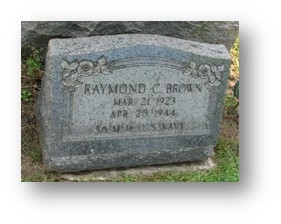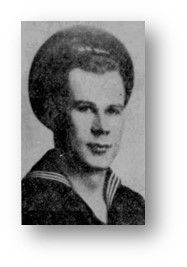Name: Brown, Raymond Charles, SO3, USN
Local address: RFD#3 Matawan (Morganville, NJ) – Brown was a 1941 Matawan High graduate
Raymond, born February 15, 1896 in Marlboro Township, was the third of four children of Raymond Brown (1896-1962) and Vera Esposito (1897-1983). Raymond’s father worked as a farmer and carpenter.
He attended the Morganville Grammar School (one of 16 students in his class) and went on to Matawan High School, where he graduated in 1941 (in his class was Spafford Walling Schanck, Jr, a soldier killed in Germany in December of 1941.). He was an excellent athlete, and was a pitcher for the Morganville Barons, a local semi-pro baseball team active in the 1940s. Prior to his induction he reportedly worked for the Armstrong Cork Company in Keyport.
He registered for the draft on June 30, 1942, and was described as 6’1” tall, 180 pounds, blue eyes, brown hair, ruddy complexion and had a scar on his left leg. He enlisted in the Navy in December 1942, and after basic training was assigned to the USS Kimberly (DD-521), a Fletcher class destroyer recently completed at the Bethlehem Steel Company in Staten Island. Naval muster rolls place him aboard the ship the day it was commissioned, May 22, 1943, making him a “plank owner.”
After a shakedown cruise off Norfolk, it departed for the Pacific in September 1943. After training off Pearl Harbor, the ship transited to Makin Island in November, and was then involved in the Gilbert Islands campaign, conducting anti-submarine screens and supporting Marines with its 5” guns.
After action at Tarawa, it returned to its home port of San Francisco for repairs and then to the Aleutian Islands as part of Task Force 94. It departed Attu in February of 1944 to shell Japanese shore batteries, and then remained off Alaska for various bombardment and ASW missions.
Raymond was reported killed on April 20, 1944. Although apparently not in action, the circumstance remains unclear, although subsequent newspaper articles noted he died of “multiple extreme injuries”.
The Kimberly’s war diary indicated that they were moored in Kuluk Bay off the Adak Naval Station that date. Weather a few days before was poor, and destroyers are small ships and don’t tolerate severe storms well. Raymond was a sonarman, and his workstation would be in the combat information center, a secure area in the middle of the ship. But accidents often occur going up and down ladders, or unsecured machinery could have fallen on him. There was no mention of a casualty in the war diary, which is not unusual – that info would be in the ship’s log. While many naval logs for US Naval ships are available at the National Archives and can be reviewed digitally, the Kimberly’s is not. Why this is so is unclear – the ship survived the war.
 What I can’t explain in the muster roll taken aboard the ship on April 23, 1944 – several days after his reported death. It indicates he and several other sailors were transferred off the ship – two to the Naval Hospital at Adak. The second sailor survived the war. Was Raymond already deceased, and the “transfer” was that of his body? On the 23rd the Kimberly sortied, so there may have been an operational reason for the late transfer. Destroyers would not have a doctor on board – medical issues would be referred to a navy corpsman, the rough equivalent of a registered nurse or physician’s assistant. A doctor would be on the squadron’s flagship or possibly the destroyer tender servicing the vessels. But in this case, the exact cause of his death is unknown. Since he was not killed in action, he was not awarded a Purple Heart.
What I can’t explain in the muster roll taken aboard the ship on April 23, 1944 – several days after his reported death. It indicates he and several other sailors were transferred off the ship – two to the Naval Hospital at Adak. The second sailor survived the war. Was Raymond already deceased, and the “transfer” was that of his body? On the 23rd the Kimberly sortied, so there may have been an operational reason for the late transfer. Destroyers would not have a doctor on board – medical issues would be referred to a navy corpsman, the rough equivalent of a registered nurse or physician’s assistant. A doctor would be on the squadron’s flagship or possibly the destroyer tender servicing the vessels. But in this case, the exact cause of his death is unknown. Since he was not killed in action, he was not awarded a Purple Heart.
Raymond was buried in the military cemetery in Adak and was returned to the United States in September of 1944. He is buried in the Old Tennent Churchyard with family members. His older brother Leo A. Brown (1919-2002) was a Seabee with the Navy in WWII.


NO COMMENTS